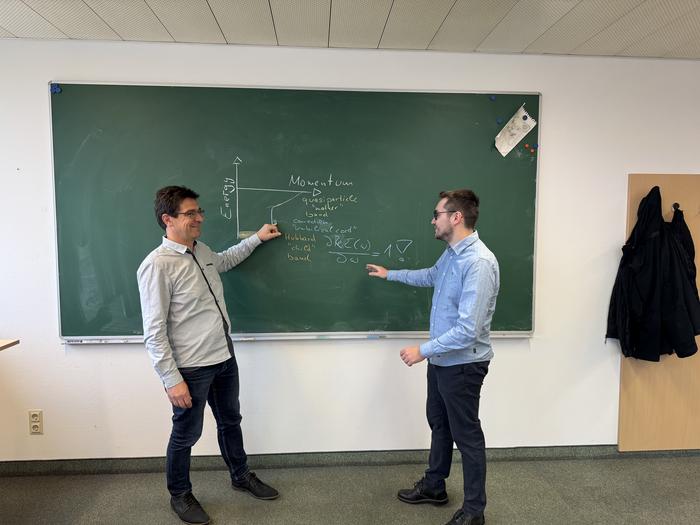In the realm of quantum physics, the exploration of allowed and forbidden energy states has unveiled astonishing insights into the behavior of materials. Researchers at the Vienna University of Technology have disclosed compelling findings about the transitions electrons can make between distinct energy bands, a phenomenon that significantly influences the conductivity of various materials. Notably, these discoveries highlight a new type of state that lies between conventional electrical conductors and insulators, opening new avenues for advanced material applications.
The notion of energy band theory is foundational in understanding the electronic properties of materials. In essence, electrons within an atom are confined to specific energy levels; they cannot occupy levels in between. This limitation is similarly reflected in the case of solids, where entire bands of energy seem permissible while others are prohibited. The delineation between conducting metals and insulative materials comes down to how these energy bands are structured and how electrons behave within them.
Historically, insulators feature widely separated energy bands with substantial gaps that render electron transitions impossible. Conversely, conductive metals possess a seamless arrangement of these bands, allowing electrons to transition freely, thereby facilitating electric current flow. Yet, the groundbreaking work from the team led by Professors Karsten Held and Juraj Krsnik has revealed that unusual phenomena can challenge these long-standing principles. Their research illustrates that, under certain conditions, new energy bands can emerge between these established categories due to strong electron interactions.
In 2007, the discovery of a peculiar transition region in cuprate materials sparked intrigue within the scientific community. However, the recent investigations from TU Wien indicate that these observations were not isolated instances but rather indicative of a more generalized behavior observable under sufficient electron interaction strength. When such interactions are strong, they can induce the formation of additional states between traditional conductors and insulators, presenting exciting implications for the semiconductor industry and beyond.
Central to this research is the concept of quantum jumps—shifts between permissible energy values. In the atomic context, electrons exhibit the ability to leap between designated energy levels. This principle, however, expands in solid states where entire bands come into play. The complexity arises when assessing how electrons manage their energy and momentum within the context of band theory. The interplay of these parameters governs their behaviors, especially during transitions facilitated by external influences, such as doping.
Doping involves introducing impurities or additional atoms into a semiconductor to modify its electronic properties by enhancing electron interactions. The research suggests that fine-tuning these interactions can lead to a unique phenomenon where a single energy band bifurcates into two connected bands, creating transitional states that had not been fully explored before. This ‘umbilical cord effect,’ as described by Held, signifies a fascinating exploration of how dual bands can coexist, linked by a momentum point that permits a continuum of energy states.
Through ongoing experimentation, Krsnik and Held have elucidated this umbilical cord effect, demonstrating that it is not merely a peculiarity but a standard occurrence under specified conditions of electron interactions. This vital revelation shifts traditional views of material classification, revealing a broader spectrum of electronic behaviors than previously acknowledged. Their findings resonate deeply within the field of solid-state physics, potentially paralleling past groundbreaking discoveries, such as the research leading to the Nobel Prize in topological states in superconductors.
These insights come at a critical juncture, as the quest for new materials harnessing unique electronic properties grows ever urgent. Understanding the nuances of energy band formation can catalyze innovations in semiconductor technologies, energy storage, and other applications demanding precisely engineered electrical characteristics. This newly characterized continuum between conductors and insulators may very well play a pivotal role in advancing future technologies.
Beyond the implications for material science, this research embodies the essence of scientific inquiry—a commitment to uncovering the underlying principles that govern the material world. The tantalizing prospects emerging from TU Wien’s investigations signify a paradigm shift in our understanding of solid-state physics, emphasizing how intricate relationships between electron interactions can lead to groundbreaking developments.
As the team continues to investigate these unexpected connections, the integration of advanced analytical techniques will prove essential for further revelations. The detailed metrics associated with quantum states, energy distributions, and momentum interactions promise a wealth of knowledge to be harvested, shedding light on the foundational aspects of material behaviors in quantum physics.
In conclusion, the observations presented by Karsten Held and Juraj Krsnik pave the way for a new chapter in the study of materials, where the boundaries between conductors and insulators are more porous than once thought. These discoveries not only challenge existing paradigms but also curate an exciting pathway towards the future of electronic materials, enabling advancements that could shape the next generation of technology.
Subject of Research: Not applicable
Article Title: Local correlations necessitate waterfalls as a connection between quasiparticle band and developing Hubbard bands
News Publication Date: 2-Jan-2025
Web References: 10.1038/s41467-024-55465-7
References: None available
Image Credits: TU Wien
Keywords
Quantum theory, energy bands, electron interaction, conductors, insulators, doping, solid-state physics, quasiparticle band, Hubbard bands, TU Wien, advanced materials, technology innovation.
Tags: Advanced materialsDoping in semiconductorsElectron interactionsEnergy band theoryHubbard bandsMetal-insulator transitionQuantum materialsQuantum physicsQuasiparticle bandsSolid-state physicsStrong electron correlations.TU Wien research





